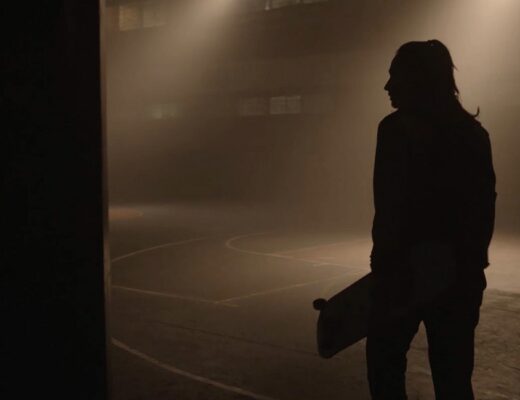The syntactically redundant title of Tomonari Nishikawa’s latest film provides a subtle hint as to what the filmmaker is up to. If one watches the film, one will discern that the title explains exactly what is in the frame. A series of images shot at a Japanese summer festival, Light, Noise, Smoke and Light, Noise, Smoke consists of shots of the night sky illuminated by a fireworks display. So aside from the black of the sky, which in this case is a sort of stand-in for the movie screen in the dark, Nishikawa shows us the colored sparks of the pyrotechnics themselves (“light”), the haze left in their wake (“smoke”), and a soundtrack recorded at the time of filming (“noise”). The double title, meanwhile, refers to Nishikawa composing the film from two separate reels of similar material.
But fans of experimental cinema may lodge an objection here, because aside from the screen, the light, the noise, and the smoke, there is one additional component in this system. That is the film apparatus itself, and by subjecting his footage to a mathematically derived form of editing, Nishikawa permits the celluloid, the camera, and the projector to assert their own particular identities. The filmmaker shot Light, Noise, Smoke using a Super-16 camera that allowed the image (“light”) to spill over onto the optical soundtrack. With optical sound, the recording head translates noise into a strip of light, which is then reinterpreted as sound by the head on the projector. But since both machines — camera and projector — must accommodate these two mechanical functions, they are synced but separated. That is, the sound is recorded on the strip exactly 26 frames ahead of the image, with a similar spacing between the playback head and the projector gate.
So instead of recording synchronized sound from the fireworks display, Nishikawa simply recorded more “light,” which is then read as sound, or “noise.” Using this 26-frame distance as his primary editing principle, Nishikawa cut both reels into 26-frame segments, which he then spliced together non-continuously. At the midway point of the film, it becomes evident that Nishikawa is alternating shots from the two reels, generating a rhythmic thumping that plays contrapuntally against the bursting light images, which themselves Nishikawa sometimes runs in reverse.
In six short minutes, Light, Noise Smoke, and Light, Noise, Smoke transforms a familiar sight into a pulsating tone poem. The fireworks’ dispersal, sparks falling from the sky while smoke hangs in the air, provides a minimum of visual information, such that at times it seems we are looking at the film grain itself. Like an analog equivalent to digital pixels, the film provides discrete points of light, which are themselves reinterpreted as audio, resulting in a regular alternation of bass tones. Fireworks, which are typically launched in conjunction with some popular observance, here become a celebration of our ability to see and hear, giving proof through the night that our consciousness is still there.
Published as part of IFFR 2024 — Dispatch 2.







